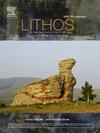Revisiting the high temperature Darongshan-Shiwandashan granitoids in the South China: A response to slab tearing associated with diachronous collision between Indochina and South China blocks
IF 2.9
2区 地球科学
Q2 GEOCHEMISTRY & GEOPHYSICS
引用次数: 0
Abstract
The Darongshan-Shiwandashan granite belt (DSGB) is composed of S-type granites and granodiorite intrusions, which are characterized by high- or ultrahigh-temperature cordierite, orthopyroxene, and granulite xenoliths. The petrogenesis of these plutons is a subject of debate, and a thorough overview of regional tectonic evolution and geochemistry is still absent despite the numerous research conducted in this granite belt. This study is a comprehensive overview of geochronology, whole-rock major-trace elements, Sr![]() Nd isotopes, and zircon Hf
Nd isotopes, and zircon Hf![]() O isotopes in the DSGB, focusing on their petrogenesis and tectonic setting of formation. The geochronological data indicates that DSGB granitoids emplaced at ca. 250 Ma, with a southwestward-younging trend. Moreover, mineral assemblages of cordierite + orthopyroxene suggest that the DSGB was formed in a high-temperature (∼850 °C) and low-pressure (3.7–6 kbar) tectonic setting. Three main plutons (Darongshan, Jiuzhou, and Taima) of the DSGB exhibit distinctly different compositions. The Darongshan and Taima granitoids display high silica (SiO2 = 68.65–78.10 wt%), low-maficity (FeO + MgO = 1.97–7.28 wt%), along with negative whole-rock εNd(t) values (−13.9 to −9.7) and elevated initial 87Sr/86Sr values (0.71638 to 0.73165). The Jiuzhou granitoids, on the other hand, exhibit relatively low silica (SiO2 = 63.90–72.72 wt%) and high maficity (FeO + MgO = 3.03–9.88 wt%), with largely overlapping but relatively high εNd(t) values ranging from −12.9 to −9.9 and lower initial 87Sr/86Sr values from 0.71453 to 0.72401. Two-component mixing model results indicate these different compositions represent varying degrees of mixing between crust- and mantle-derived magmas, with 0–10 %, 0–20 % and 20–40 % basaltic melts involved for Taima, Darongshan and Jiuzhou plutons, respectively. The subducting slab tearing, induced by the diachronous collision between the South China Block (SCB) and Indochina Block (ICB), provide the most feasible interpretation for the petrogenesis and spatio-temporal geochemical pattern of the granitic rocks in the DSGB. The onset of the diachronous collision initiated at the Hainan-Yunkai massif, southwest of SCB, while the Tethys Ocean still existed in the northwest (Nanpanjiang area), causing notable disparities in the convergence velocities of the subducting ocean slab. The heterogeneous stresses resulting from the different subduction rates were accommodated by bending and tearing of the subducting slab. Then, ultrahigh-temperature basaltic melts derived from the decompression melting of the lithospheric mantle facilitated the melting of metasedimentary rocks, which resulted in the formation of high-temperature S-type granitoids. The Jiuzhou pluton, located at the center of slab tearing, received more mantle contributions than the Darongshan and the Taima plutons, which are emplaced away from the slab tearing center. The younging trend in age from the Darongshan to Jiuzhou and Taima plutons indicates a progressive tearing from the northeast (the far end of the subducting slab) to the southwest.
O isotopes in the DSGB, focusing on their petrogenesis and tectonic setting of formation. The geochronological data indicates that DSGB granitoids emplaced at ca. 250 Ma, with a southwestward-younging trend. Moreover, mineral assemblages of cordierite + orthopyroxene suggest that the DSGB was formed in a high-temperature (∼850 °C) and low-pressure (3.7–6 kbar) tectonic setting. Three main plutons (Darongshan, Jiuzhou, and Taima) of the DSGB exhibit distinctly different compositions. The Darongshan and Taima granitoids display high silica (SiO2 = 68.65–78.10 wt%), low-maficity (FeO + MgO = 1.97–7.28 wt%), along with negative whole-rock εNd(t) values (−13.9 to −9.7) and elevated initial 87Sr/86Sr values (0.71638 to 0.73165). The Jiuzhou granitoids, on the other hand, exhibit relatively low silica (SiO2 = 63.90–72.72 wt%) and high maficity (FeO + MgO = 3.03–9.88 wt%), with largely overlapping but relatively high εNd(t) values ranging from −12.9 to −9.9 and lower initial 87Sr/86Sr values from 0.71453 to 0.72401. Two-component mixing model results indicate these different compositions represent varying degrees of mixing between crust- and mantle-derived magmas, with 0–10 %, 0–20 % and 20–40 % basaltic melts involved for Taima, Darongshan and Jiuzhou plutons, respectively. The subducting slab tearing, induced by the diachronous collision between the South China Block (SCB) and Indochina Block (ICB), provide the most feasible interpretation for the petrogenesis and spatio-temporal geochemical pattern of the granitic rocks in the DSGB. The onset of the diachronous collision initiated at the Hainan-Yunkai massif, southwest of SCB, while the Tethys Ocean still existed in the northwest (Nanpanjiang area), causing notable disparities in the convergence velocities of the subducting ocean slab. The heterogeneous stresses resulting from the different subduction rates were accommodated by bending and tearing of the subducting slab. Then, ultrahigh-temperature basaltic melts derived from the decompression melting of the lithospheric mantle facilitated the melting of metasedimentary rocks, which resulted in the formation of high-temperature S-type granitoids. The Jiuzhou pluton, located at the center of slab tearing, received more mantle contributions than the Darongshan and the Taima plutons, which are emplaced away from the slab tearing center. The younging trend in age from the Darongshan to Jiuzhou and Taima plutons indicates a progressive tearing from the northeast (the far end of the subducting slab) to the southwest.

重访华南大荣山-十完山高温花岗岩类:与中南块体历时碰撞相关的板块断裂响应
大荣山—石万山花岗岩带(DSGB)由s型花岗岩和花岗闪长岩侵入体组成,以高温或超高温堇青石、正辉石和麻粒岩包体为特征。这些岩体的岩石成因一直是一个有争议的话题,尽管对这一花岗岩带进行了大量的研究,但对区域构造演化和地球化学的全面概述仍然缺乏。本文对该地区的年代学、全岩主微量元素、SrNd同位素和锆石HfO同位素进行了综合研究,重点探讨了其成因和形成的构造背景。地质年代学资料表明,DSGB花岗岩类就位时间约为250 Ma,具有向西南方向年轻化的趋势。堇青石+正辉石的矿物组合表明,DSGB形成于高温(~ 850℃)和低压(3.7-6 kbar)构造环境。DSGB的3个主要岩体(大荣山、九州和台马)的组成差异明显。大容山和台马花岗岩类表现出高硅质(SiO2 = 68.65 ~ 78.10 wt%)、低镁质(FeO + MgO = 1.97 ~ 7.28 wt%)、负的全岩εNd(t)值(- 13.9 ~ - 9.7)和高的初始87Sr/86Sr值(0.71638 ~ 0.73165)。九州花岗岩类的硅含量相对较低(SiO2 = 63.90 ~ 72.72 wt%),丰度相对较高(FeO + MgO = 3.03 ~ 9.88 wt%),重叠较多,但εNd(t)值较高,范围为−12.9 ~−9.9,初始87Sr/86Sr值较低,范围为0.71453 ~ 0.72401。双组分混合模型结果表明,这些不同的成分反映了壳幔岩浆的混合程度不同,分别为0 - 10%、0 - 20%和20 - 40%的玄武岩熔体参与了台马、大荣山和九州岩体的混合。华南陆块与印度支那陆块的历时碰撞导致的俯冲板块撕裂,为DSGB花岗质岩石成因和时空地球化学模式提供了最可行的解释。跨时碰撞起始于南海西南的海南-云凯地块,而西北(南盘江地区)仍存在特提斯洋,导致俯冲洋板收敛速度存在明显差异。不同俯冲速率引起的不均匀应力通过俯冲板的弯曲和撕裂来调节。岩石圈地幔减压熔融产生的超高温玄武岩熔体促进了变质沉积岩的熔融,形成高温s型花岗岩。位于板块撕裂中心的九州岩体比远离板块撕裂中心的大容山和台马岩体接受了更多的地幔贡献。大容山—九州—台马岩体年龄的年轻化趋势表明,从东北(俯冲板块远端)到西南是一个渐进的撕裂过程。
本文章由计算机程序翻译,如有差异,请以英文原文为准。
求助全文
约1分钟内获得全文
求助全文
来源期刊

Lithos
地学-地球化学与地球物理
CiteScore
6.80
自引率
11.40%
发文量
286
审稿时长
3.5 months
期刊介绍:
Lithos publishes original research papers on the petrology, geochemistry and petrogenesis of igneous and metamorphic rocks. Papers on mineralogy/mineral physics related to petrology and petrogenetic problems are also welcomed.
 求助内容:
求助内容: 应助结果提醒方式:
应助结果提醒方式:


